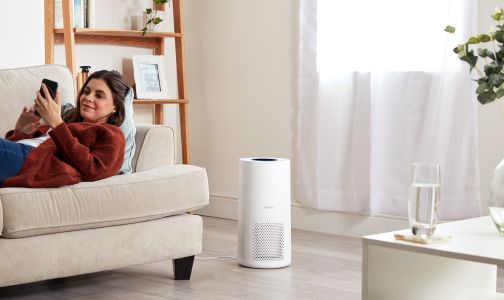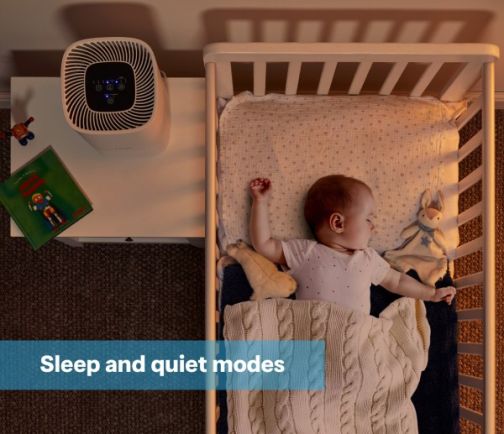National Clean Air Day: Don't let your allergies get the best of you

Whilst it’s easy to think of air pollution as an outdoor problem, we humans spend a lot of our time indoors – at home, at work, at school, or when we go to shops or restaurants. So, this National Clean Air Day, why not also take a few minutes to consider what you could do to improve the air quality in your home?
From chemicals in cleaning products and hair sprays to dust, pollen and pet dander, our home environments probably aren’t as healthy as they could be. On average, we spend more than 90% of our time indoors, so doing what we can to achieve clean, fresh and healthy indoor air is essential.
The most common types of indoor air pollution are microscopic particles of dust and dirt in the air, or gases such as carbon monoxide. There can be many causes of indoor air pollution, but common ones include home heating methods, damp and moisture build up and chemicals in household products. To see a more detailed list of the causes of poor indoor air quality and ways you can combat it, take a look at our blog - How to Improve Indoor Air Quality at Home.
As well as changing our habits and behaviours, there are also a range of different air treatment products available to us. A dehumidifier can help control the levels of moisture in your home, or an air purifier can help combat troublesome airborne allergens and irritants.
At Dimplex we offer a range of air purifiers including the newly released Brava range. Ideal for use in the bedroom, living spaces and children’s bedrooms, these quiet, sleekly designed air purifiers remove contaminants that build up, leaving cleaner, fresher indoor air. Particularly good news for those prone to allergies and asthma, especially during hay fever season.
Did you know?
- Indoor air can contain more than 900 chemicals, particles and biological materials with potential health effects, and can be up to 50 times more polluted than outdoor air
- Indoor air pollution from biological agents in indoor air related to damp and mould increases the risk of respiratory disease by 50%. (World Health Organisation – WHO)
- 58% of people have experienced mould or condensation in their homes
- Over 98% of indoor particles are invisible to the human eye. Our eyes can see particles above 40 microns in size, but bacteria can be as small as 0.05 micron and noxious gases as small as 0.001 microns
- A staggering 44% of British adults now suffer from at least one allergy and the number of sufferers is on the rise, growing by around 2 million between 2008 and 2009 alone. Almost half (48%) of sufferers have more than one allergy**
- You can check the daily forecasted levels of air pollution in your area.

Nick Paul, Portable Product Manager at Glen Dimplex Heating & Ventilation, provides some expert advice on how to freshen the air in your home…
Q: Why should we be concerned about the quality of the air in our home?
"Radical changes in design and construction methods of domestic buildings over the past two decades mean that our homes are better sealed and insulated. While they might be warmer and more energy efficient, they are unable to breathe naturally. This lack of ventilation means that the level of pollutants in our indoor air often exceeds those found in outdoor air."
Q: What causes these high levels of VOCs?
"High levels of VOCs can be caused by everyday objects and activity. Cooking and heating appliances, paints, solvents, carpets, cleaning products, toiletries and even our pets, all release VOCs into the air. On top of this, outdoor contaminants from traffic and industry can enter homes through open windows and doors. Exposure to this potent mix of airborne particles in the home is being termed ‘Toxic Home Syndrome,’ with an estimated 15.3 million homes in the UK believed to be at risk of this. We spend more than 90% of our time indoors, so there is a very real need to take action."
Q: Why do you need an air purifier?
"Deciding why you need an air purifier will help narrow down the type of technologies that you will need. If someone in your home has allergies, then choose a purifier that features a HEPA filter, or if you’re looking for an easy way to neutralise cooking smells in your kitchen, a purifier with carbon filtration is ideal. For all-around use then look for a model that features a combination of filtration stages – the more stages of filtration, the cleaner the air will be."
Q: What does an air purifier do?
"Air purifiers draw in air from the room and filter it to release fresher, cleaner air, helping to eliminate the pollen, dust and other particles that make us cough and sneeze. This makes them a must-have for allergy, asthma and hay fever sufferers."
Q: How does it work?
"Air purifiers use a fan to pull in dirty air at one end, remove pollutants, and output clean air at the other end. As air passes through the air purifier, the HEPA filter traps 99.7% finer particles, including pollen, dust mites, mould spores and pet dander, and the ultraviolet-C (UVC) helps eliminate viruses and germs. A carbon filter then ensures any unwanted odours and toxic fumes are reduced. Finally, an Ioniser removes airborne allergens and enhances immunity."
Q: What size air purifier do you need?
"Different purifiers can be used for different sized rooms, so make sure that you pick a model that will best suit the room dimensions it will be used in. Dimplex products provide optimum room size guides with to help with the decision-making process and typical air changes per hour. In addition, we also state the Clean Air Delivery rate - the higher the rating the greater the efficiency/power of the air purifier (air volume moved per minute). It is also worth considering whether you want your purifier to be standing on the floor or ‘table-top’ style, depending on where in the room you decide to use it. The weight and physical dimensions should also be thought about if you intend on moving the purifier around the home as needed."








